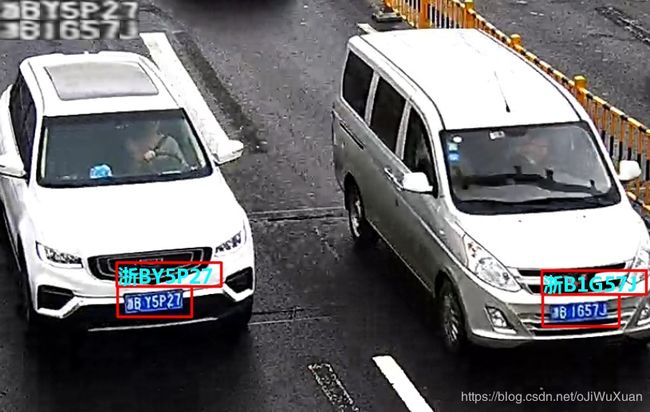HyperLPR 对图片和视频中车牌的识别
一、概要
在上一篇文章中,主要介绍了HyperLPR开源车牌识别系统的配置和使用(链接:https://blog.csdn.net/oJiWuXuan/article/details/107332668),目前这个系统是我用过的开源车牌识别程序中最精准最稳定的,很多模糊的、角度倾斜的、恶劣天气下的车牌都能识别清楚,作为开源程序来说已经非常优秀了。但是上一篇文章主要是在虚拟环境中的配置及HyperLPR的简单使用,并没有涉及HyperLPR在实际场景中的应用,如对具体图片或者视频中车牌的识别并输出识别后的图片或视频。在这一篇文章中,对HyperLPR 对图片和视频中车牌的识别进行详细的介绍。
二、配置
这里不再具体的在虚拟环境中配置HyperLPR了,而是将HyperLPR中程序的主文件直接放到固定的文件夹中,好处就是后续需要结合业务场景优化功能时,方便直接在源码上进行修改来实现。当然,虚拟环境中的其他模块还是要安装好的,比如TensorFlow、opencv-python、keras等,而且要注意这些模块的版本。这里用的模型是HyperLPR官方直接训练好的模型,对识别国内一般的车牌而言已经足够了。
我们先从github上下载下来完整的HyperLPR文件并解压缩。
github:https://github.com/zeusees/HyperLPR。
然后新建一个文件夹,我这里命名为HyperLPR-V0.1,接着将HyperLPR中的hyperlpr_py3、model、font三个文件夹复制过来,再将我们要用的一些图片啊视频啊放到data文件夹下,文件夹目录如下图所示。
三、图片识别
首先是对图片的识别,车牌识别程序的核心代码主要是在hyperlpr_3中的pipline.py文件中,这里要对pipline.py中的def SimpleRecognizePlate函数进行部分修改,如下:
## 识别图片中的车牌
def SimpleRecognizePlate(image, save_path):
t0 = time.time()
# 读取图片
image = cv2.imread(image)
images = detect.detectPlateRough(image,image.shape[0],top_bottom_padding_rate=0.1)
res_set = []
for j,plate in enumerate(images):
plate, rect, origin_plate =plate
# plate = cv2.cvtColor(plate, cv2.COLOR_RGB2GRAY)
plate =cv2.resize(plate,(136,36*2))
t1 = time.time()
ptype = td.SimplePredict(plate)
if ptype>0 and ptype<5:
plate = cv2.bitwise_not(plate)
image_rgb = fm.findContoursAndDrawBoundingBox(plate)
image_rgb = fv.finemappingVertical(image_rgb)
cache.verticalMappingToFolder(image_rgb)
print("e2e:", e2e.recognizeOne(image_rgb))
image_gray = cv2.cvtColor(image_rgb,cv2.COLOR_RGB2GRAY)
# image_gray = horizontalSegmentation(image_gray)
# cv2.imshow("image_gray",image_gray) # 显示分割出来的灰色车牌截图
# cv2.waitKey()
# cv2.imwrite("./"+str(j)+".jpg",image_gray) # 保存分割出来的灰色车牌截图
# cv2.imshow("image",image_gray)
# cv2.waitKey(0)
print("校正",time.time() - t1,"s")
# cv2.imshow("image,",image_gray)
# cv2.waitKey(0)
t2 = time.time()
val = segmentation.slidingWindowsEval(image_gray)
# print val
print("分割和识别",time.time() - t2,"s")
if len(val)==3:
blocks, res, confidence = val
print('--------------------{}--------------------'.format(res))
if confidence/7>0.7:
image = drawRectBox(image, rect, res)
res_set.append(res)
for i,block in enumerate(blocks):
block_ = cv2.resize(block,(25,25))
block_ = cv2.cvtColor(block_,cv2.COLOR_GRAY2BGR)
image[j * 25:(j * 25) + 25, i * 25:(i * 25) + 25] = block_
if image[j*25:(j*25)+25,i*25:(i*25)+25].shape == block_.shape:
pass
if confidence>0:
print("车牌:",res,"置信度:",confidence/7)
else:
pass
# print "不确定的车牌:", res, "置信度:", confidence
# 显示车牌识别结果的图片
cv2.imshow("image", image)
k = cv2.waitKey(0)
if k == 27: # 按下esc时,退出
cv2.destroyAllWindows()
elif k == ord('s'): # 按下s键时保存并退出
cv2.imwrite(save_path, image)
cv2.destroyAllWindows()
# print(time.time() - t0,"s")
# return image,res_set
然后在我们建立的lpr_image.py文件中写入调用上述函数的代码:
from hyperlpr_py3 import pipline as pp
import cv2
image = 'data/009.jpg'
save_path = 'output-image/MySaveImage.jpg'
pp.SimpleRecognizePlate(image, save_path)
print('-------------')
执行后就可在output-image文件夹中生成车牌识别后的图片了,下面是车牌识别的结果。可见识别效果还是不错的。
四、视频识别
接下来是对视频文件中车牌的识别,我们还是在hyperlpr_3中的pipline.py文件中进行修改,这里新建一个def SimpleRecognizePlate_video的函数,代码如下所示。
# 识别视频中的车牌
def SimpleRecognizePlate_video(video, save_path):
# t0 = time.time()
# 读取视频
cap = cv2.VideoCapture(video)
time.sleep(2.0)
# 获取窗口大小
size = (int(cap.get(cv2.CAP_PROP_FRAME_WIDTH)), int(cap.get(cv2.CAP_PROP_FRAME_HEIGHT)))
# 设置帧率
fps = 60
# 调用VideoWrite()函数,保存处理后的视频
videoWrite = cv2.VideoWriter(save_path, cv2.VideoWriter_fourcc(*'DIVX'), fps, size)
# 从视频读取数据, 读取成功 ret为True,否则为False,frame里面就是一个三维数组保存图像
ret, frame = cap.read()
while True:
for iii in range(1):
ret, frame = cap.read() # 每5帧取一次 加速计算
# grab the frame from the threaded video stream
# ret, frame = cap.read()
if ret is False:
print('No data, break.')
break
image = frame
# 对图片中的车牌进行识别
images = detect.detectPlateRough(image,image.shape[0],top_bottom_padding_rate=0.1)
res_set = []
for j,plate in enumerate(images):
plate, rect, origin_plate = plate
# plate = cv2.cvtColor(plate, cv2.COLOR_RGB2GRAY)
plate =cv2.resize(plate,(136,36*2))
# t1 = time.time()
ptype = td.SimplePredict(plate)
if ptype>0 and ptype<5:
plate = cv2.bitwise_not(plate)
image_rgb = fm.findContoursAndDrawBoundingBox(plate)
image_rgb = fv.finemappingVertical(image_rgb)
cache.verticalMappingToFolder(image_rgb)
# print("e2e:", e2e.recognizeOne(image_rgb))
image_gray = cv2.cvtColor(image_rgb,cv2.COLOR_RGB2GRAY)
# print("校正",time.time() - t1,"s")
# cv2.imshow("image,",image_gray)
# cv2.waitKey(0)
# t2 = time.time()
val = segmentation.slidingWindowsEval(image_gray)
# print val
# print("分割和识别",time.time() - t2,"s")
if len(val)==3:
blocks, res, confidence = val
print('--------------------{}--------------------'.format(res))
if confidence/7>0.7:
# 绘制车牌识别框
image = drawRectBox(image, rect, res)
res_set.append(res)
for i,block in enumerate(blocks):
block_ = cv2.resize(block,(25,25))
block_ = cv2.cvtColor(block_,cv2.COLOR_GRAY2BGR)
image[j * 25:(j * 25) + 25, i * 25:(i * 25) + 25] = block_
if image[j*25:(j*25)+25,i*25:(i*25)+25].shape == block_.shape:
pass
if confidence>0:
print("车牌:",res,"置信度:",confidence/7)
else:
pass
# print "不确定的车牌:", res, "置信度:", confidence
cv2.imshow("Frame", image)
key = cv2.waitKey(1) & 0xFF
# if the `q` key was pressed, break from the loop
if key == ord("q"):
break
# 保存帧为视频
videoWrite.write(image)
cv2.destroyAllWindows()
cap.release()
# print(time.time() - t0,"s")
然后在我们建立的lpr_video.py文件中写入调用上述函数的代码:
from hyperlpr_py3 import pipline as pp
import cv2
video = 'data/test.mp4'
save_path = 'output-video/MySaveVideo.avi'
pp.SimpleRecognizePlate_video(video, save_path)
print('-------------')
执行后就可在output-video文件夹中生成车牌识别后的视频了,下面是视频中的截图。由于视频质量着实堪忧,所以识别效果有时候会有一些误差,但总体识别情况还是挺好的。
本文的详细代码已上传至 github: https://github.com/jiwuxuan/HyperLPR-Meow。
可供参考。


